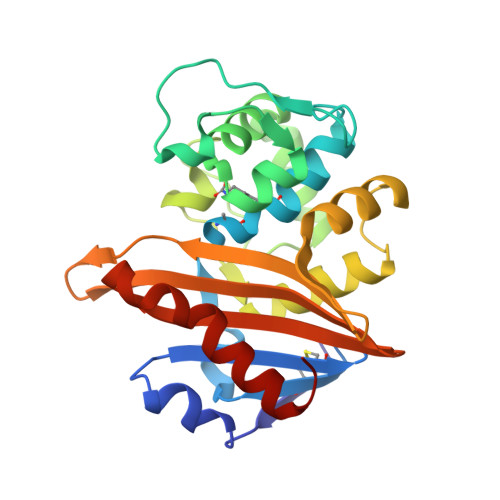Studies on enmetazobactam clarify mechanisms of widely used beta-lactamase inhibitors.
Lang, P.A., Raj, R., Tumber, A., Lohans, C.T., Rabe, P., Robinson, C.V., Brem, J., Schofield, C.J.(2022) Proc Natl Acad Sci U S A 119: e2117310119-e2117310119
- PubMed: 35486701
- DOI: https://doi.org/10.1073/pnas.2117310119
- Primary Citation of Related Structures:
6T35, 7B3R, 7B3S, 7B3U - PubMed Abstract:
¦Â-Lactams are the most important class of antibacterials, but their use is increasingly compromised by resistance, most importantly via serine ¦Â-lactamase (SBL)-catalyzed hydrolysis. The scope of ¦Â-lactam antibacterial activity can be substantially extended by coadministration with a penicillin-derived SBL inhibitor (SBLi), i.e., the penam sulfones tazobactam and sulbactam, which are mechanism-based inhibitors working by acylation of the nucleophilic serine. The new SBLi enmetazobactam, an N-methylated tazobactam derivative, has recently completed clinical trials. Biophysical studies on the mechanism of SBL inhibition by enmetazobactam reveal that it inhibits representatives of all SBL classes without undergoing substantial scaffold fragmentation, a finding that contrasts with previous reports on SBL inhibition by tazobactam and sulbactam. We therefore reinvestigated the mechanisms of tazobactam and sulbactam using mass spectrometry under denaturing and nondenaturing conditions, X-ray crystallography, and NMR spectroscopy. The results imply that the reported extensive fragmentation of penam sulfone¨Cderived acyl¨Cenzyme complexes does not substantially contribute to SBL inhibition. In addition to observation of previously identified inhibitor-induced SBL modifications, the results reveal that prolonged reaction of penam sulfones with SBLs can induce dehydration of the nucleophilic serine to give a dehydroalanine residue that undergoes reaction to give a previously unobserved lysinoalanine cross-link. The results clarify the mechanisms of action of widely clinically used SBLi, reveal limitations on the interpretation of mass spectrometry studies concerning mechanisms of SBLi, and will inform the development of new SBLi working by reaction to form hydrolytically stable acyl¨Cenzyme complexes.
Organizational Affiliation:
Chemistry Research Laboratory, Department of Chemistry, University of Oxford, Oxford OX1 3TA, United Kingdom.





















